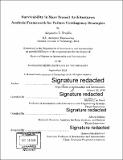| dc.contributor.advisor | Olivier L. de Weck and Afreen Siddiqi. | en_US |
| dc.contributor.author | Trujillo, Alejandro E. (Alejandro Elio) | en_US |
| dc.contributor.other | Massachusetts Institute of Technology. Department of Aeronautics and Astronautics. | en_US |
| dc.date.accessioned | 2019-02-14T15:51:54Z | |
| dc.date.available | 2019-02-14T15:51:54Z | |
| dc.date.copyright | 2018 | en_US |
| dc.date.issued | 2018 | en_US |
| dc.identifier.uri | http://hdl.handle.net/1721.1/120441 | |
| dc.description | Thesis: S.M., Massachusetts Institute of Technology, Department of Aeronautics and Astronautics, 2018. | en_US |
| dc.description | Cataloged from PDF version of thesis. | en_US |
| dc.description | Includes bibliographical references (pages 125-129). | en_US |
| dc.description.abstract | Ambitious goals for exploring Mars in the coming decades will push human spaceflight into new territory in duration, distance and isolation. In this regime, loss of system integrity due to some failure becomes especially dire. To that end, much meaningful work has centered on designing highly reliable space systems with low tolerance to failure. However, this thesis identifies a gap in space mission safety engineering within the realm of "survivability". Survivability is the ability of a system to address failure via contingency operations and to place the system in a state in which Loss of Mission, Vehicle or Crew are prevented. Manned space mission survivability is investigated in the context of decades-out missions - such as a Martian voyage in the late 2030's - which at the present time exhibit significant technological uncertainty. An abstracted functional breakdown beginning from assumed mission/campaign objectives and logically required architectural elements is proposed. Such a "generalized architecture" allows for a function-based failure and response analysis applicable across many possible futures. The Failure-Survivability Analysis Framework for Early Concepts (Fail-SAFE) is developed which 1) defines a generalized architecture, 2) injects a functional failure and assesses its impact, 3) enumerates and evaluates failure response options and 4) synthesizes these findings into design recommendations to promote system survivability. Particular emphasis is placed on those response options which leverage "functional multiplicity", or a redundancy in high-level functions across major architectural elements that can be substituted in case of failure. The framework is applied to two Case Studies. The first investigates a decompression failure during the outbound phases of a Mars transit mission. A Failure Effect Metric is defined which evaluates the impact and severity of the failure and Object Process Methodology is employed to determine its downstream effects. Contingency strategies (i.e. sets of response options) are generated and evaluated for their potential effectiveness. The analysis yielded a 108 contingency strategies, when limiting a strategy to a maximum of 4 individual responses. Recommendations to promote survivability to the failure are derived from these findings. The second Case Study validates the framework by applying it to a historical scenario - the Apollo 13 failure. The framework reproduces and highly appraises the successful course of action taken to save the crew. This validated framework may allow mission planners to design for survivability from the earliest stages of the architecting process, trading a narrowly optimal design for one robust to failure. | en_US |
| dc.description.statementofresponsibility | by Alejandro E. Trujillo. | en_US |
| dc.format.extent | 129 pages | en_US |
| dc.language.iso | eng | en_US |
| dc.publisher | Massachusetts Institute of Technology | en_US |
| dc.rights | MIT theses are protected by copyright. They may be viewed, downloaded, or printed from this source but further reproduction or distribution in any format is prohibited without written permission. | en_US |
| dc.rights.uri | http://dspace.mit.edu/handle/1721.1/7582 | en_US |
| dc.subject | Aeronautics and Astronautics. | en_US |
| dc.title | Survivability in Mars transit architectures : analysis framework for failure contingency strategies | en_US |
| dc.type | Thesis | en_US |
| dc.description.degree | S.M. | en_US |
| dc.contributor.department | Massachusetts Institute of Technology. Department of Aeronautics and Astronautics | |
| dc.identifier.oclc | 1084655728 | en_US |
